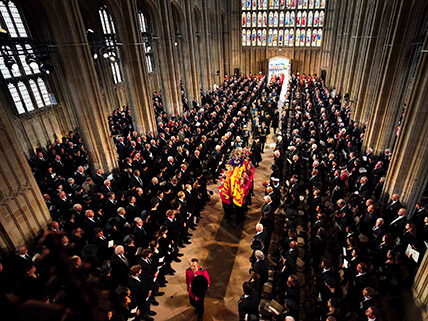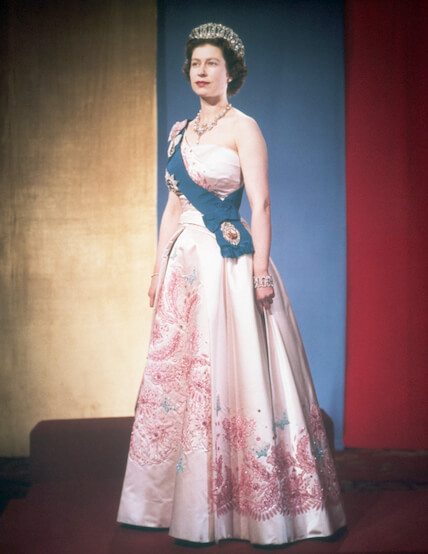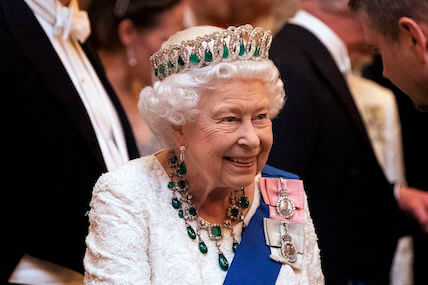
Members of the royal family follow the coffin during the Committal Service for Queen Elizabeth II at St George’s Chapel, at Windsor Castle, Windsor, England, Monday Sept. 19, 2022.
Queen Elizabeth II of the United Kingdom died on September 8, 2022 after more than 70 years on the throne. She reigned longer than any other monarch in British history. In fact, only one ruler in all of world history is known to have reigned longer than she did. Upon her death, the crown passed to her oldest son, who became King Charles III.
The future queen was born in 1926, the niece of King Edward VIII. When Edward abdicated his throne in 1936, her father became King George VI and Elizabeth became his heir. As a teenager during World War II, she made public addresses, especially among young people. In 1952, less than a decade after the war ended, her father died. Only 26 years old, Elizabeth became queen. Her televised coronation in July 1953 was a worldwide event, attracting more than 20 million viewers.

Queen Elizabeth II in 1950, dressed for a formal occasion. She wears her family’s orders and orders of her kingdom on the sash over her shoulder, and several items of family jewelry.
As queen, Elizabeth presided over sweeping changes in the United Kingdom and the rest of the world. She witnessed the end of the Cold War, the creation of the European Union, and her kingdom’s exit from that same union. She also oversaw the end of the British Empire. During her reign, the last of Britain’s colonies won their freedom. As queen, Elizabeth was also the head of the Commonwealth of Nations. This alliance of 56 countries, most of them former British territories, works together to promote peace and democracy. Fifteen members of the Commonwealth—including Canada, Australia, and New Zealand—recognized Elizabeth as their queen and head of state.
The announcement of the queen’s death triggered outpourings of grief through the United Kingdom, the Commonwealth, and other parts of the world. Many had viewed the queen as a symbol of their country and an almost grandmotherly figure. Huge crowds gathered outside the royal residence at Buckingham Palace near London to mourn her. Her funeral service on September 19 was marked by a stately procession through the streets of London. Hundreds of thousands of people lined the route to pay tribute to the queen as millions more watched on television. More than 100 world leaders had gathered for the ceremony, paying respects on behalf of their countries.
The death of the queen will require immediate practical changes within the United Kingdom. The national anthem, “God Save the Queen,” will be changed to its older version, “God Save the King.” The queen’s image also appears on British money, and her symbol can be seen on flags, mailboxes, and government documents throughout the kingdom. Over the next several years, these will be phased out and replaced with new versions depicting King Charles. Similar changes will take place in Commonwealth countries, such as Canada, who also depict the queen on their money.

Queen Elizabeth II talks to guests at an evening reception for members of the Diplomatic Corps at Buckingham Palace on December 11, 2019. Notice that her crown is the same one she is wearing in the photo from 1950.
The queen’s death also brought out mixed feelings. In many former British colonies, the British monarchy was seen as a symbol of oppression and brutal colonialism. Media coverage about the queen therefore stirred up feelings of anger and lingering resentment. Although Elizabeth II had not been in power during Britain’s empire-building, many people felt she had not done enough to acknowledge the treatment of those who suffered under British rule. Citizens of several Commonwealth countries called for removing the British monarch as their official head of state. Even within the United Kingdom, many wondered whether it was time to end the British monarchy.
Elizabeth II had been incredibly popular, even with many people who did not support the monarchy in principle. Her successor, Charles III, however, is much less popular. Some observers predict that the queen’s death will increase calls for the abolition of the monarchy by activists who consider it an outdated—and expensive—relic of the past.
Image credits:
Funeral of Queen Elizabeth II ©Ben Birchall/Pool/AP Images
Queen Elizabeth II in 1950 ©Bettmann/Getty Images
Queen Elizabeth II ©Victoria Jones/WPA Pool/Getty Images
Sources
- Announcement of the Death of the Queen
(Source: The Royal Household of the United Kingdom, accessed September 30, 2022) - Queen Elizabeth II has died
(Source: BBC, accessed September 30, 2022) - Queen Elizabeth II dies at 96
(Source: CNN, accessed September 30, 2022) - Queen Elizabeth II dead at 96 after 70 years on the throne
(Source: AP News, accessed September 30, 2022) - Queen’s death leaves the world mourning
(Source: ABC News, accessed September 30, 2022) - Queen Elizabeth II funeral: Nation pays final farewell
(Source: BBC, accessed September 30, 2022) - State funeral ends 11 days of ceremonies
(Source: ABC News, accessed September 30, 2022) - The Queen is dead, long live the King—or are the monarchy’s days numbered?
(Source: The Guardian, accessed September 30, 2022) - The queen’s death opens the floodgates on self-rule campaigns
(Source: Politico, accessed September 30, 2022) - With Queen Elizabeth II’s death, what changes in the UK?
(Source: USA Today, accessed September 30, 2022)



